Probably because you left your system alone. You didn't put your hands in again.Hey Travis,
must been a busy few weeks, and I’ve been neglecting my tank. Funny enough, my cherry bomb, pink and red Millis, and red tables are all looking great and more colorful. Just tested my nutrients:
Phosphates 0.08
Nitrates 15
Alk 7.5
who knows why they’re looking better tho!
Navigation
Install the app
How to install the app on iOS
Follow along with the video below to see how to install our site as a web app on your home screen.
Note: This feature may not be available in some browsers.
More options
You are using an out of date browser. It may not display this or other websites correctly.
You should upgrade or use an alternative browser.
You should upgrade or use an alternative browser.
How to successfully keep SPS Corals!
- Thread starter revhtree
- Start date
- Tagged users None
- Joined
- Apr 23, 2019
- Messages
- 31
- Reaction score
- 71
This tank has been up and runnings since February 2017. The rock had been established in other tanks. Some of it was a years old and others were months. There were a couple rocks straight from the ocean. The sand bed was out of a high phosphate crashed tank. I rinsed it out before I put it in. It is about 2 or 3 inches deep. There was mud and some weeds in the back corner from the Mission Bay. (Pacific) 10 gallons of the water was out of the ocean and it was 60% filled with ocean water from the local aquarium that pumps it through some kind of a filter before it gets to a tap for public use. From Feb till about September it was home to a pet octopus harvested in northern San Diego. We kept old reef lights on it during this time and the pod population grew.
The octopus lived with us for a little over a year, not really sure, at least two seasons with a chiller before we sent him to a better place.
Phosphates were pretty high and there was Cyano on the back wall. There were Malaysian clams living in the sand that were left over octopus food. I dumped some non scientific amount of swimming pool quality Lanthanum Chloride in the tank and the levels went to undetectable on my Salifert test kit.
The skimmer was an old euroreef with 2 cobalt needed wheel pumps on it. Not really any to quantify the flow, but it seemed to skim well. (Switched it yesterday for a reef octopus 150 with a controllable dc pump.)
The tank was fallow for about 6 weeks? During that time I manually dosed calcium, magnesium and sodium carbonate to get my parameters where I wanted them and make sure they stayed. We added a Caribbean blue tang and a Scrawled Cowfish to test the water. Then we started adding frags from our starter tank that was now around 16 months old. (Dates are very approximated.)
The tank is 120g with a 30ish gallon sump.
I generally shoot for:
ALK; 9.5 - 12 DKH
Cal; 450
Mag; 1400
Nitrate; close to 0 (on salifert)
Phosphate; close to 0 (on salifert)
1.025 salinity
76 degrees F
12x water volume turn over through the sump per hour.
I landed on my numbers pretty arbitrarily. The back of a business card I got at MACNA in San Diego, the label off of my salt mix and the ambient temperature of my house. Well, that combined with what I could remember from keeping a reef in the 90's.
My reef in the 90's used Kalkwasser and the high pH/DKH seemed to pay off. I use a calcium reactor now and I prefer the high DKH for help keep my pH up. I have had the least problems with my tank when I am over 9.5 DKH. Unfortunately the business card I found recommended phosphate levels >.2 ppm, and that is high enough to scare me a little. Phosphate gets blamed for too many tank crashes. I am just more comfortable keeping it low until I get some peer reviewed research on it.
For this reason I had to resort to the PO4 recommendation chart on my salt mix bucket. When I do change water, I use the Red Sea salt mix. The bucket says less than .03 PO4, and that is what I want to hear. I they have made great products like skimmers and tanks since clear back to the 80's. I went with the black bucket line because of the graphics. (It is the same way I choose my wine.) I think that their aquarium building skill in no way reflects their ability to mix salt. Instant ocean was more affordable and I used it for a long time but I have a degree in art and I feel like the graphics on their bucket are borderline offensive. If Tunze made a salt mix with better graphics than Red Sea, I might use that since I like their pumps and skimmers.
Some times I just throw caution to the wind and use ocean water since I live 5 miles away from it. There just isn't any compelling data that I could call Proof that one is going to be better for my coral or my system than another. Some are closer to where I want my levels to be than others and it makes life easier. With my once every two or three years water change schedule I am not sure that it would matter how good or bad the salt is.
Circulation is 2x mp-40 blowing across the tank in anti sync from each other on upper front of the side walls. 2x mp-10 mounted on the back edge of the right side wall. They are always on at 90%.
Light is Radion. G4pro. Two 30's and two 15's. I did some research before buying them and felt like they were the best for me at the time. I have not considered non LED options. I have used the others in the past but I think I just love the tech. The light is on about 10 hours a day. There have times when it was on for 12. I normally have a ramp up time of primarily blue light for two hours and ramp down for two hours. I use a corral lab preset in mid day and just blue, purple, white and 1/2 red on the ramp portions. I am currently running the lights at 70% on these settings and the highest par value is 550. Lowest is 110. I have run them brighter and better color seemed to coincide but there are always other variables so I cant point directly at PAR.
I really cant remember which coral got there first. You cant guess based on size. They all came in as frags the size of my the end of my little finger. About three of them were the size of a car key. I have some that are still the same size a year later and others that earn me a few hundred a month in frag sales and trade. The tank kills clams as a general rule. I am sure that there are still one or two Malaysian clams in there. There is a Derasa clam that has beaten the odds. Maximas will look good for a while, inevitably they fall off the shelves and are dead within a day of hitting the sand. We are pretty sure there is a predator in the sand bed.
Fish, 20 springeri damsel, 1 dragon face pipe, Scopas, Mimic yellow, Lavender tangs. Couple pair of goby, 2 barnacle blend, 4 red firefish, 4 purple firefish, yellow spotted wrasse, Pair of green mandarine goby, 2 breeding pair cardinals, Green wrasse, sixtine wrasse, copper band butterfly, and some others that I cant think of. The barnacle blennys are the only fish that are male and felmale that do not breed on a regular basis.
More than 30 various sized hermit crabs, more than 20 emerald crabs, two fire red shrimp, one cleaner shrimp, 8 Acropora crabs, bunch of Trochus,and nerites (they breed a lot), 10 turbo snails, 10 ? astria snails, 20+ random snails.
The tank is on an auto feeder that dumps much more food than the fish can eat in 10 minutes twice a day. I have not really focused on one specific kind of food other than usually more pellet than flake.
I make an effort to not impact my plankton population. No filter socks, or traps. I use propeller pumps, Main drive pump has a design that seems to do less damage than the pumps of the 90's. I believe that the microfauna population is one of the keystones of my system. At any given time I can pull half cup of water out of it and see things moving around with a magnifying glass. In the night it is even more dramatic. My cardinals spend the nights constantly feeding on whatever comes out at night.
The sump grows Chaetomorpha. (At my house we pronounced it Keeto because we pronounce algae as al-gee. Strange scientific latin derivatives.) We modeled the system based on the "Dynamic Aquaria" book from the 90's that is basically all about algae turf scrubbers. It is our main source of nutrient export. I believe it works as a giant buffer for fluctuations in my system. I have a 150 watt purple "grow light" from amazon on it. The more I feed, the faster it grows. There seems to always be some level of PO4 and often no Nitrate. I have tried supplementing nitrate, but I would prefer to just feed more often. It is not a perfect science. The tank is over crowded with fish and I see some stress from it.
I use GFO. I use little and run a 1/4 cup charge for about a year. I have turned off the skimmer and pulled the GFO on my other small reef, but it has only been 6 or 8 months and I am still waiting to see if I am ok with it.
I have tried to work out some kind of scheduled maintenance on the system but things just kind of work on their own. I am sure that I clean the skimmer at least once every 9 days, but I dont clean it unless it has got liquid in it and normally the neck is coated with 1/8 inch of sludge.
I harvest Chaeto when there is no room for it in the grow area. It is lit reverse daylight from my tank and runs 16 hours. It does make a dent in the pH drop at night, but not a big dent.
I generally hate testing my water. Normally it is about 3 days after I have decided that I need to test before I actually do it. If I find a problem, I normally correct it pretty quickly. (2 or 3 days) During any correction I test a least daily but normally am and pm. I recently got an apex, but before that I used a Seneye. It would text me when temp or pH was off. I think it is important to have some kind of live monitor on those 2 things.
I run a calcium reactor. I like the idea of it. It puts minerals and organics back into the water in the proportions that they came out. I run magnesium at a 1:10 ratio with crushed coral from 2 fishes. Research says all suppliers are different. Since that one worked for me I will just use it as long as it is available.
I check my ALK 2x a day when I have made an adjustment to the reactor or drip rate. When things stabilize, 2 days later I cut the test frequency in half each time I see the same level with 2 consecutive tests.
The system never had an intentional water change until this week after a one month period of troubleshooting tissue loss on random corals. I gave up and just started diluting the problem until I could get more information. I use ICP testing as a snap shot of what is going on when the tank looks good and bad. I try to have one test per quarter with some notes and photos. I have some corals that are always the same colors but I do get dramatic shifts in some when I change lighting, food, or GFO.
My tank looked best here (if it looks like a frag, I probably got it as a stick.)
//lab.atiaquaristik.com/share/7d9605e7a3bda51bceb4







And here
//lab.atiaquaristik.com/share/6119d18b9a1c9cd255be











Nice aquarium.
I am not new to reefing or SPS Corals, been keeping them around 10 years with good growth, but have some questions about color and branching.
In my newest tank I have 2 xr30 pro gen 4 with 4x ati blue t5s as supplement. I run the t5's 5 hours a day during peak in my radio schedule. My acros have great health great polyp extension, and seem to be growing pretty rapidly. Most of my SPS is encrusted 4-5 inches around where I glued the frag.
My biggest concern is my colors are kind of washed out. Not bleached, not brown, just not as multi colored as when I bought them. My WD for example is primarily green base, with green polyp, and slight blue around the tips. When I bought it had yellow, and orange, and pink and all sorts of other colors, now it's just mostly green. Why would that be?
Also most of my Acropora seems to encrust great (at least every frag has 4-5 inches encrusted beyond the original frag), but very slow to start branching...Any ideas on that too?
Flow: 2x mp40 anti sync on opposite sides of tank, variations of reef crest and gyre throughout the day. Also have 2x gyre xf330 on opposite sides of the tank in anti sync as well.
Alk (Apex Trident): 7.5 pretty rock solid
Calc (Apex Trident): 460
Mag (Apex Trident): 1400
Nitrate (RedSea pro): ~5ppm
Phosphate (Hannah ULR) : .06-.1 (I know this on the high side, but when I try to reduce I often bottom it at 0 and my corals are not happy)
PH (Apex): 8.1-8.2 depending on light cycle
I'm currently dosing ~25ml of Cal and Alk a day over 6 doses each day.
In my newest tank I have 2 xr30 pro gen 4 with 4x ati blue t5s as supplement. I run the t5's 5 hours a day during peak in my radio schedule. My acros have great health great polyp extension, and seem to be growing pretty rapidly. Most of my SPS is encrusted 4-5 inches around where I glued the frag.
My biggest concern is my colors are kind of washed out. Not bleached, not brown, just not as multi colored as when I bought them. My WD for example is primarily green base, with green polyp, and slight blue around the tips. When I bought it had yellow, and orange, and pink and all sorts of other colors, now it's just mostly green. Why would that be?
Also most of my Acropora seems to encrust great (at least every frag has 4-5 inches encrusted beyond the original frag), but very slow to start branching...Any ideas on that too?
Flow: 2x mp40 anti sync on opposite sides of tank, variations of reef crest and gyre throughout the day. Also have 2x gyre xf330 on opposite sides of the tank in anti sync as well.
Alk (Apex Trident): 7.5 pretty rock solid
Calc (Apex Trident): 460
Mag (Apex Trident): 1400
Nitrate (RedSea pro): ~5ppm
Phosphate (Hannah ULR) : .06-.1 (I know this on the high side, but when I try to reduce I often bottom it at 0 and my corals are not happy)
PH (Apex): 8.1-8.2 depending on light cycle
I'm currently dosing ~25ml of Cal and Alk a day over 6 doses each day.
Last edited:
Thanks for the advice! Your tank is absolutely stunning!I did this writeup on our local board. A little copy and paste from there:
A quick writeup with my experience of SPS corals over the last three and a half years:
SPS are finicky - at least for me they are.
"Nothing good happens fast in a reef tank" - this saying pretty much sums up my philosophy.
SPS= Stability Promotes Success - the other part of my philosophy.
Swinging parameters, high nutrients, poor lighting, lack of flow: All of these factor into the success of a tank that is trying to grow SPS. They can stunt growth, cause STN/RTN (slow tissue necrosis/rapid tissue necrosis), brown polyps, or just flat out kill them.
Parameter checks:
Salinity - I check my salinity monthly with a refractometer. If you don't own a refractometer, do yourself a service and get one. $40 in this hobby is cheap, and salinity is critical to the success of any reef aquarium. Don't rely on the swing arms - they simply have too many variables and are typically pretty inaccurate.
pH - I run a calcium reactor, and probably have low pH. However, I don't measure it in my actual tank, just my reactor. This is my preference. If anything starts going wrong, and I've exhausted all other possibilities, then I may look into pH.
Calcium - 420 all day long. You can run it higher, but from what I've read, it doesn't do that much more for calcification of hard corals. Any lower than 380, and I've seen the negative effects start to occur - lack of growth namely.
Alkalinity - I run m Alk around 9.0-9.5 dKh. This is one parameter that has quite a bit of play in it. I've seen people running 15 dKh, and people that run ULNS (ultra low nutrient systems), like Neo, typically run their Alk closer to natural seawater, or around 7 dKh. Any lower than 7, and I've experienced zero growth and STN. I have also raised my Alk too high, too fast. I did this about 15 months ago in my 75. I nearly crashed the tank, cemented the sand bed, and caused STN in my SPS for several months. I lost quite a few really nice pieces, but overall, I managed to pull out of it with pretty good luck. I have a few coral that are still recovering from the Alk spike. I test Alk weekly, or daily if/when I make adjustments to my reactor
Magnesium - I run my Mg right around 1300. I test Mg bi-monthly, as I run NeoMag in my calcium reactor.
Nitrates - I prefer under 10ppm for nitrates. Any time I go over that number, I seem to experience browning out of coral and slowed growth. I maintain nitrates with water changes, feeding only pellet, nori (for tangs and foxface), occasionally mysis, and an oversized protein skimmer.
Phosphates - I don't have a good test for phosphates (not a fan of test kits for phosphates, they just don't do a good enough job). Under .03 is great for SPS. I have the Hanna handheld meter, and feel like it does a good "ballpark" job of measuring. I mostly go by the amount of algae and overall color of coral to "feel out my phosphates".
Trace elements - I don't dose anything - unless I get some phyto donatedOther than the calcium reactor, I don't manually add any chemicals to my tank. I've tried them, and haven't had great success with them, so I've reverted back to skimmer and water changes only.
Other factors
Lighting - Another factor that has a lot of variance in it. I've ran MH almost my entire SW experience, from 175s to 150s to 250s, to T5, and eventually I'll be LED. All have their drawbacks, and all have their advantages. 175s probably have the lower advantage, IMO, as they are single end only. When I was running them 7 years ago, all they really had were spider reflectors. They've since came out with some really great SE reflectors, some that rival the best double end reflectors. 150s are great for shallower tanks, and have a great advantage of lower heat. 250s are great for faster growth, but the tradeoff is more heat output into the tank. I've experienced about a 4 degree increase in temperature since I've upgraded tanks. T5s work equally as well as 250s in my experience. The growth is the same, but the colors are much better! I'm building out my LED light in the next few weeks, so I'll be able to see how that goes as well. Lighting wasn't the only factor, but it does play a big part.
Flow - This topic has many variables as well. Throughout this hobby, there are several things that people do differently. You just need to find what works best for you, and you are comfortable with. For flow, I run a closed loop (3600gph), two powerheads (2100gph & 800gph), as well as my return of about 900gph, along with an MP40 Total that up for about 10000gph through my 120. I've been contemplating adding another vortech or two, but the cost on those seems to be my limiting factor. Other than the price, I don't see a downside to the vortechs.
Skimmer - Get the biggest skimmer you can afford! This is an integral piece of equipment to success for SPS. A skimmer that is too small for an SPS system will cause nitrates and phosphates to spike. This can cause SPS to recede tissue or RTN/STN. They can also brown out or just completely die. Skimmers are very important. Don't skimp!
Bioload - I prefer to run a very light bioload for SPS tanks. This helps reduce the amount of nutrients going into my system, which means I don't have to pull as many nutrients out. I keep two clowns, a yellow and blue tang, a foxface, and a wrasse. I'd probably be okay adding a couple more fish, but they would be small and add very little to the bioload. I will eventually trade the blue tang in for another once he outgrows the tank.
Quarantine - I am living with AEFW, so I can't say enough about this. You MUST QT every coral. I plan to run numerous frags through my QT once it is set up and then into the frag tank they will go. Once I have backups of everything, I'll dose the main tank with Levamisole. Not QTing is playing russian roulette. I dipped everything before it went into my tank, and that clearly didn't work. So set up a QT and learn to use it!
Overall, I'm very pleased with my transition to a nearly all SPS tank. There have been several struggles, but they have been great building blocks over the last couple years. I look forward to the future advancement of technology and equipment to help make SPS tanks more "user friendly".
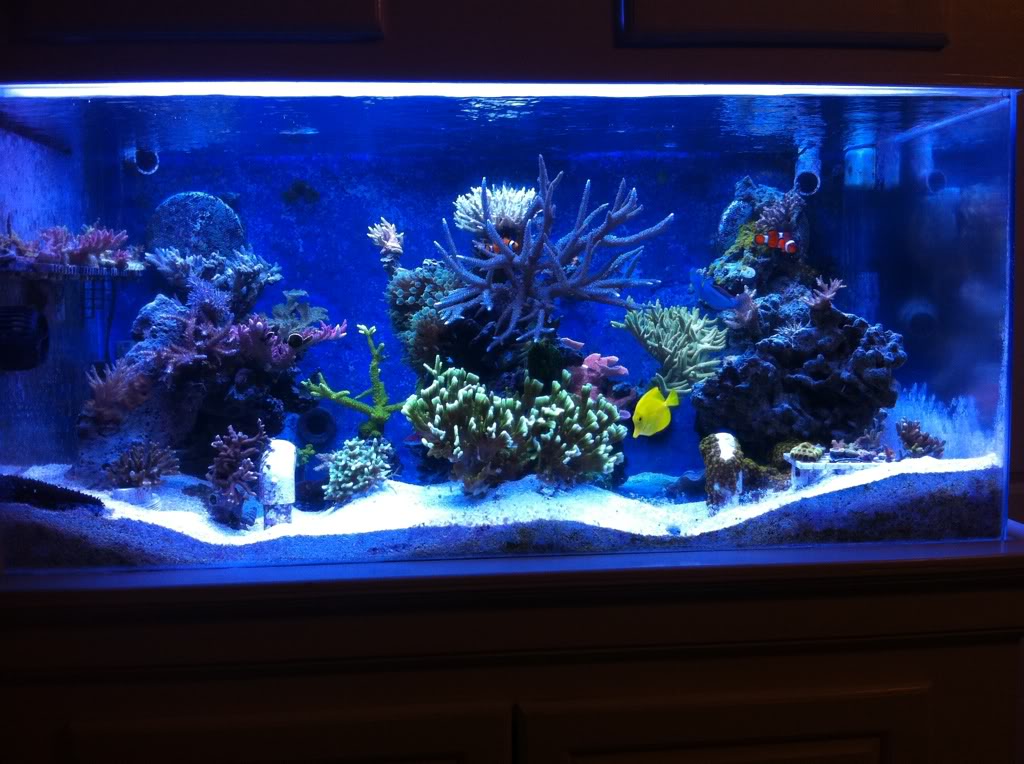
+1 on the QT. I had one tank crash due to marine velvet aquired with water of a frag. Nearly left the hobby.
What is your take on detritus built up in sand beds?
This made me laugh ... can confirm, my coral definitely prefer the NYOS nitrate test kit over the Salifert, primarily because the Salifert graphics are trash.I went with the black bucket line because of the graphics. (It is the same way I choose my wine.)
Have you checked potassium? I had washed out looking montipora when i had 0s on no3 and po4 and an oversized ats to pull it out. I also had a mirror that i wondered if silver was somehow getting in. Id check for potassium and metals via icp.I am not new to reefing or SPS Corals, been keeping them around 10 years with good growth, but have some questions about color and branching.
In my newest tank I have 2 xr30 pro gen 4 with 4x ati blue t5s as supplement. I run the t5's 5 hours a day during peak in my radio schedule. My acros have great health great polyp extension, and seem to be growing pretty rapidly. Most of my SPS is encrusted 4-5 inches around where I glued the frag.
My biggest concern is my colors are kind of washed out. Not bleached, not brown, just not as multi colored as when I bought them. My WD for example is primarily green base, with green polyp, and slight blue around the tips. When I bought it had yellow, and orange, and pink and all sorts of other colors, now it's just mostly green. Why would that be?
Also most of my Acropora seems to encrust great (at least every frag has 4-5 inches encrusted beyond the original frag), but very slow to start branching...Any ideas on that too?
Flow: 2x mp40 anti sync on opposite sides of tank, variations of reef crest and gyre throughout the day. Also have 2x gyre xf330 on opposite sides of the tank in anti sync as well.
Alk (Apex Trident): 7.5 pretty rock solid
Calc (Apex Trident): 460
Mag (Apex Trident): 1400
Nitrate (RedSea pro): ~5ppm
Phosphate (Hannah ULR) : .06-.1 (I know this on the high side, but when I try to reduce I often bottom it at 0 and my corals are not happy)
PH (Apex): 8.1-8.2 depending on light cycle
I'm currently dosing ~25ml of Cal and Alk a day over 6 doses each day.
Hi! Question. I have a very low Nitrates around 0 but my Po3 are high around 0.11 most of my corals are lsp and I have seen that some have lose color. I’m trying to rise my Nitrates but I want to lower my Po3 any suggestions? I feed my fishes 3 times a day, corals 3 times a week a mix of things every time I feed them,one of them is Brightwell’s coloramino, I use trace elements 2 a week. do u use Coloramino everyday? ThanksI'm definitely a lightweight in this discussion, but I've had my 180g up for just over a year and it was first real attempt at keeping SPS. I've been successfully keeping saltwater tanks for over a decade, but previous reef tanks were LPS & Zoa dominated. Over the first year, my growth and coloration has been good and my tank is quickly filling in.
Dosing:
For dosing, I dose 2-part via dosing pumps and magnesium manually. Once every month I adjust my dosing amount according to the system needs. I run a ULNS, so I've found that 15 drops of Brightwell's CoralAmino brings out the best coloration in my corals and prevents the pastels found in starving corals found in some tanks. I also dose 3 drops of lugols each day due to it's potassium content to help maintain blues & purples in my tank. My ATO runs through a kalk reactor to help keep Ca & Alk steady.
Water Quality:
I do 40 gallon water change every 2-3 weeks using RC salt. As far as filtration goes, I run a fuge with a DSB, Chaeto, and LR rubble. My skimmer is a Octopus Extreme 200 upgraded to a Bubble Blaster 3000 pump. I run WM EcoBak, Rowaphos, and Carbon in reactors 24/7.
Lighting:
I run 450w of LED (ReefFiltration Gen2 fixtures) along with 468w of T5. I'm confident that the LEDs can grow coral on their own, but I like having the piece of mind with the T5s producing a broader spectrum. The T5 fixtures houses 12x39w bulbs currently comprised of six ATI Blue+, two ATI Purple+, two UVL SuperActinic, and two Current 10k. Here's my light cycle:
7:00 AM: Actinic T5s ON (Actually two UVL Superactinic & two Blue+)
9:00 AM: LEDs ON
11:30 AM: Daytime T5s ON
1:30 PM: Daytime T5s OFF
4:30 PM: LEDs OFF
7:00 PM: Actinic T5s OFF
Coral Feeding:
I broadcast feed a mix of ReefNutrition Oyster Feast & Coral Frenzy every three days. Once per week I feed my tank with baby brine shrimp. Although this is predominantly for the LPS & fish, some feeder response is noticed in the SPS as well, so I'm assuming that they are feeding on the BBS.
Parameters:
I keep salinity at 1.026 and my temperature range is 79-80 F. Calcium is kept in the neighborhood of 430-450 and I keep my alkalinity at 8 DKH. While this is on the low end of preferred alk levels, I've read that maintaining higher alk levels in an ULNS can be probelmatic. Magnesium is kept between 1300-1350 and pH fluctuates between 8.3-8.5 depending on the time of day. I strive to keep nitrates, nitrites, and ammonia at zero, but many aquarists have noticed improved coloration when maintaining NO3 levels in the 5-10 range (I offset this loss of color by dosing amino acids and through supplemental feeding of my corals). I try to keep phosphates as close to zero as possible and they usually measure between 0 and 0.02 on a Hanna calorimeter.

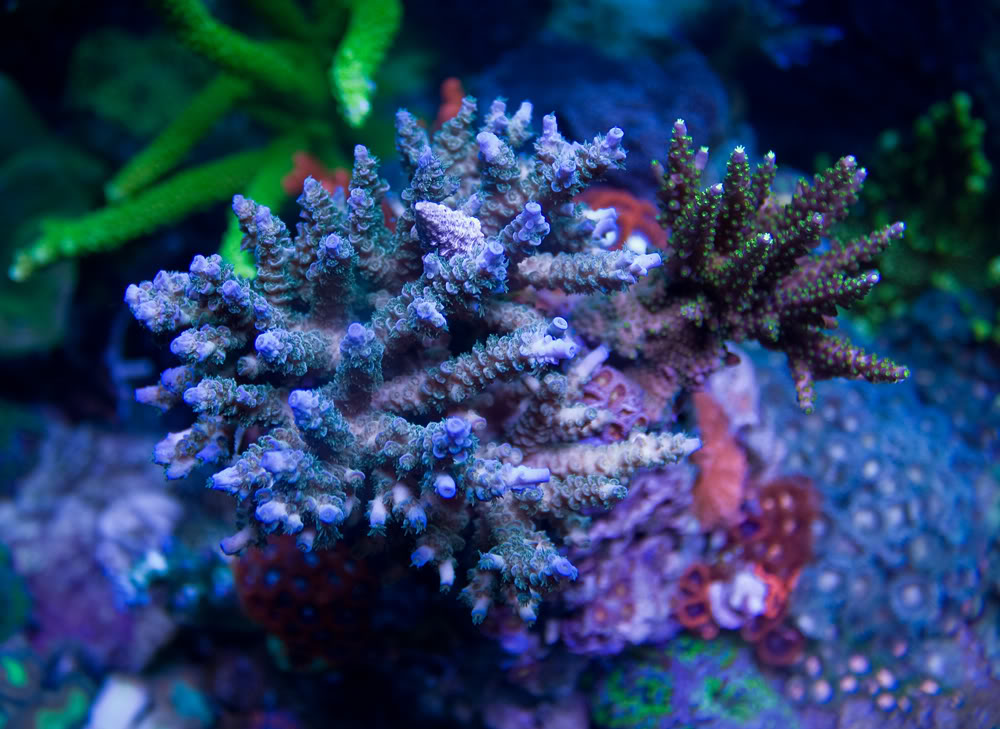
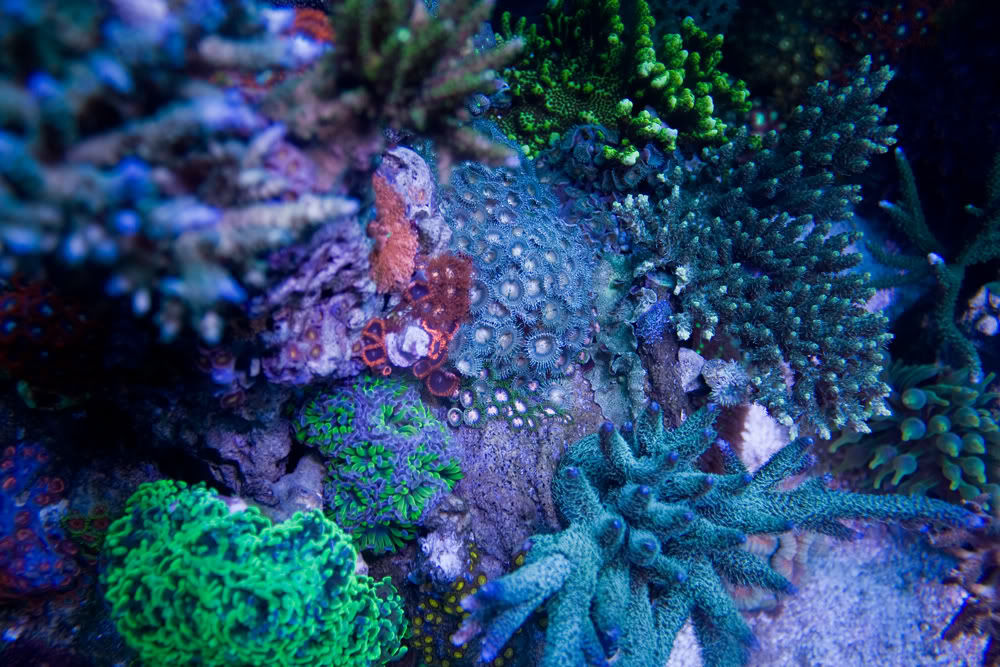
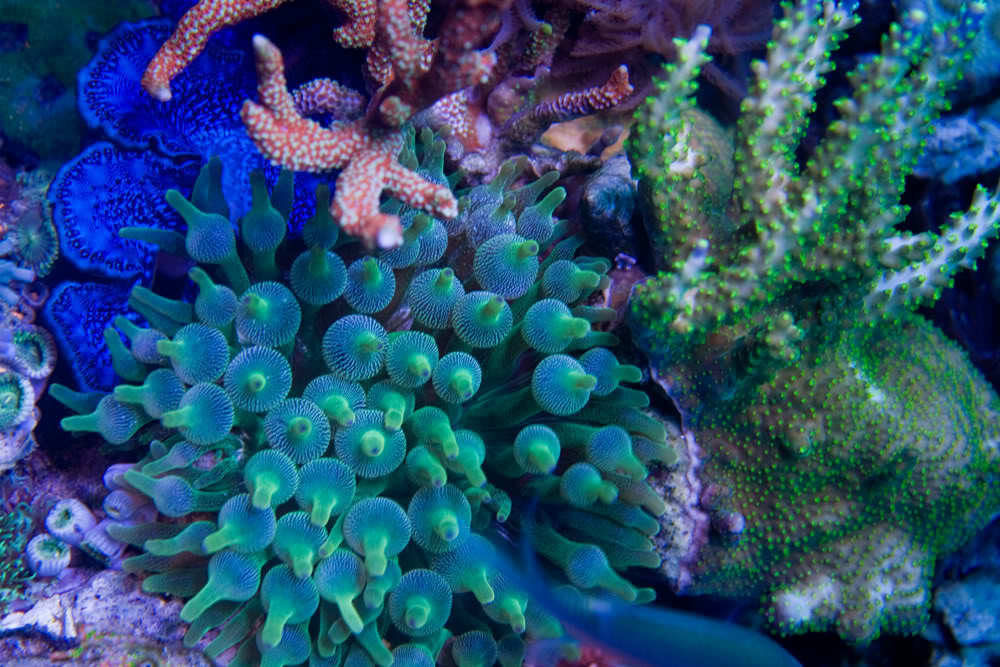
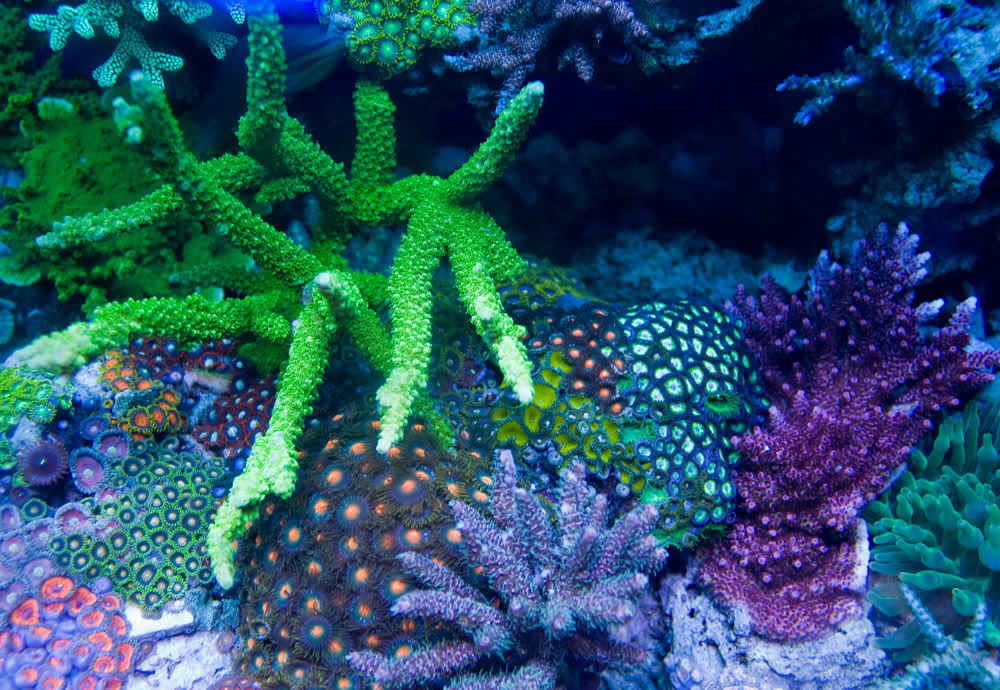
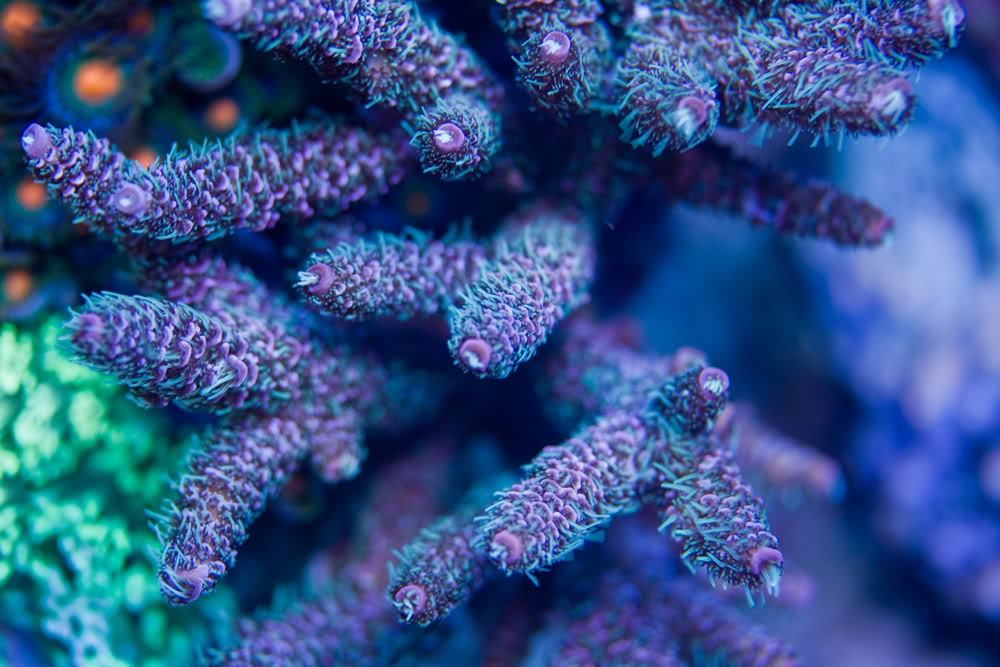
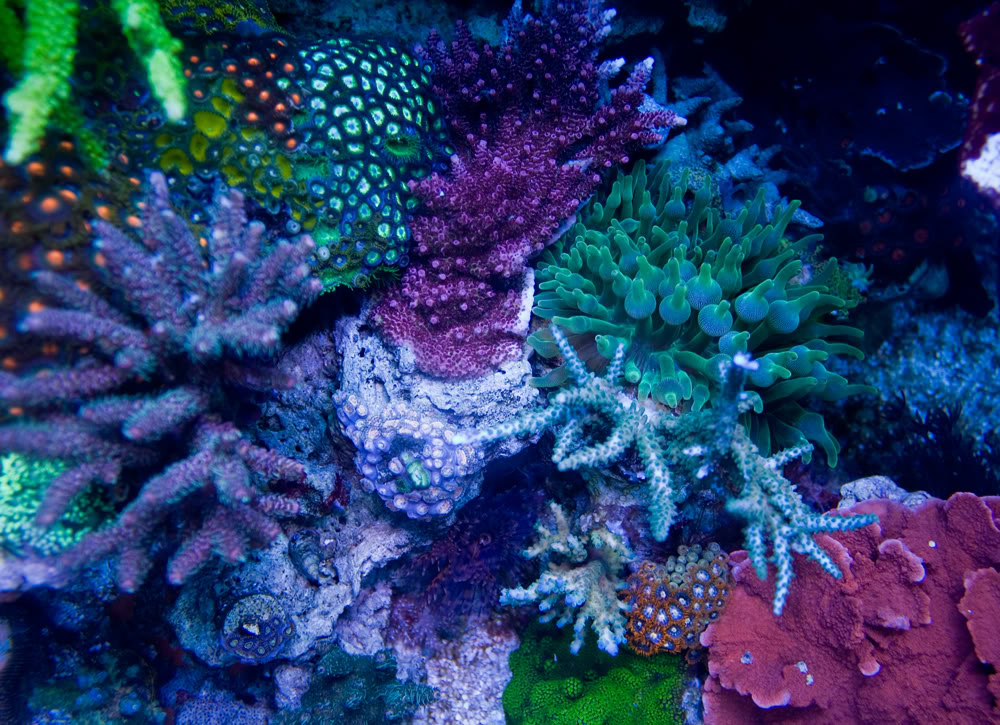
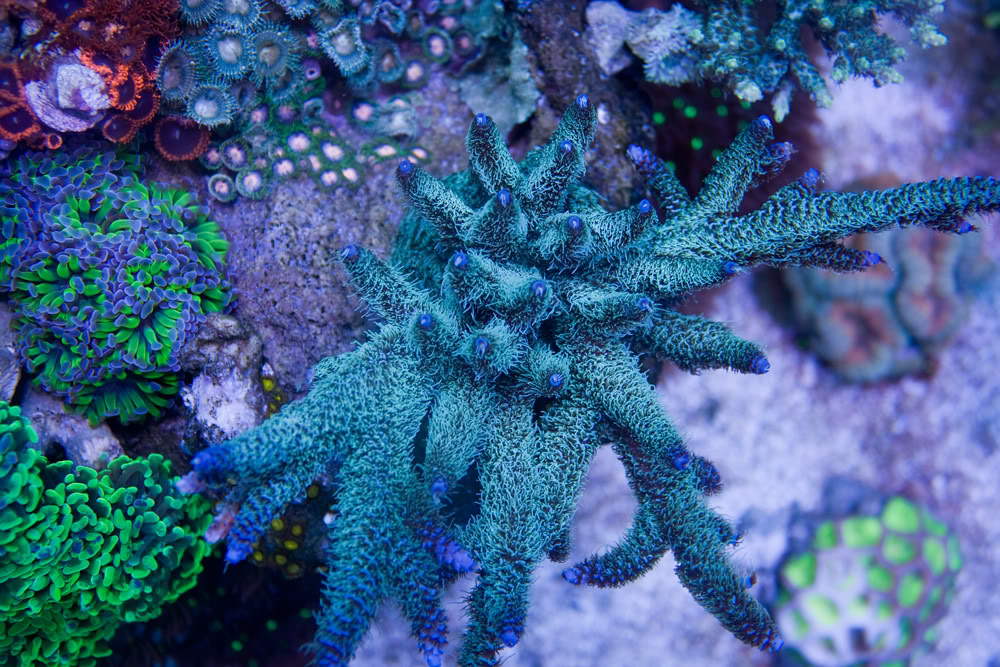
Hi Experts,
This is a great thread and there are so much we can learn regarding SPS here.
Been in this hobby (mixed reef but LPS dominated and no SPS) for about 7 years.
Started a 2nd 5ft mixed reef tank last Aug with aim of building a true mixed reef (with fish, LPS and SPS). Fast forward to Jan 2022.. the mixed reef taking shape slowly. Fishes are happy and LPS seems to be doing ok.. do see some good growth. However, i not successful with keeping any SPS alive for long.
So based on reading and recommendations.. i am going very slow with intoducing SPS into the tank. So far I only tried with a few small digitata, stylo and millie frags but all bleached within weeks.
Here are my current water levels:
Kh: 11
Cal: 440
Mag: 1435
Nitrate: 5
Nitrite: 0.01
Ammo: 0
Phos: 0
Salinity: 1.026
Temp: 25.5°c
So I was wondering:
1. Where should I zoom in to find the root cause of my issue with SPS
2. Where should I start.. to be successful with SPS
3. What should I do next?
Thanks and Happy New Year.
This is a great thread and there are so much we can learn regarding SPS here.
Been in this hobby (mixed reef but LPS dominated and no SPS) for about 7 years.
Started a 2nd 5ft mixed reef tank last Aug with aim of building a true mixed reef (with fish, LPS and SPS). Fast forward to Jan 2022.. the mixed reef taking shape slowly. Fishes are happy and LPS seems to be doing ok.. do see some good growth. However, i not successful with keeping any SPS alive for long.
So based on reading and recommendations.. i am going very slow with intoducing SPS into the tank. So far I only tried with a few small digitata, stylo and millie frags but all bleached within weeks.
Here are my current water levels:
Kh: 11
Cal: 440
Mag: 1435
Nitrate: 5
Nitrite: 0.01
Ammo: 0
Phos: 0
Salinity: 1.026
Temp: 25.5°c
So I was wondering:
1. Where should I zoom in to find the root cause of my issue with SPS
2. Where should I start.. to be successful with SPS
3. What should I do next?
Thanks and Happy New Year.
- Joined
- May 31, 2017
- Messages
- 270
- Reaction score
- 184
I run simple due to past difficulties with gear, works for me.
1L bag of regular pellet carbon passive. Changed monthly.
1.2L Zeolite stones active. Changed every 8 weeks.
No skimmer.
No rock.
No sand.
No heater.
70% WC every 3 weeks. Natural sea water.
Dose Randys Alk and Cal - 100ml/day ATM.
2x 250w Cayman halides.
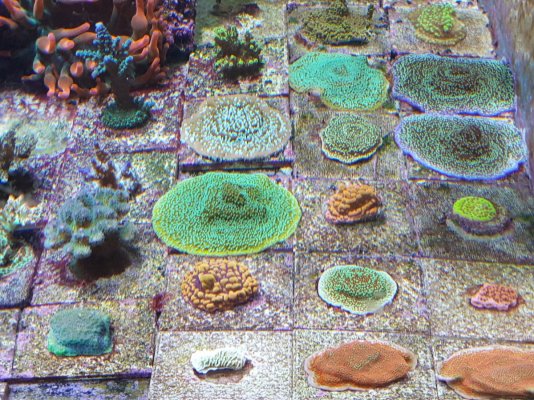
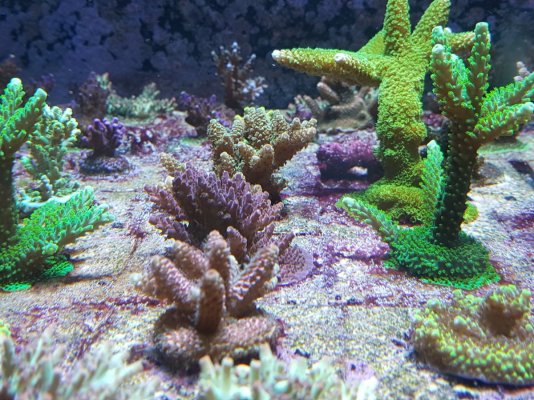
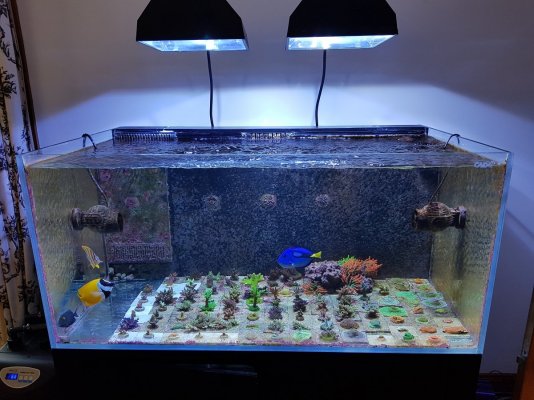
1L bag of regular pellet carbon passive. Changed monthly.
1.2L Zeolite stones active. Changed every 8 weeks.
No skimmer.
No rock.
No sand.
No heater.
70% WC every 3 weeks. Natural sea water.
Dose Randys Alk and Cal - 100ml/day ATM.
2x 250w Cayman halides.



Last edited:
- Joined
- Jan 16, 2018
- Messages
- 225
- Reaction score
- 236
I'm no expert, that being said. What does your water change schedule look like? Lighting? Do you dose any trace elements? Phos: 0 <-- this very well could be your problemHi Experts,
This is a great thread and there are so much we can learn regarding SPS here.
Been in this hobby (mixed reef but LPS dominated and no SPS) for about 7 years.
Started a 2nd 5ft mixed reef tank last Aug with aim of building a true mixed reef (with fish, LPS and SPS). Fast forward to Jan 2022.. the mixed reef taking shape slowly. Fishes are happy and LPS seems to be doing ok.. do see some good growth. However, i not successful with keeping any SPS alive for long.
So based on reading and recommendations.. i am going very slow with intoducing SPS into the tank. So far I only tried with a few small digitata, stylo and millie frags but all bleached within weeks.
Here are my current water levels:
Kh: 11
Cal: 440
Mag: 1435
Nitrate: 5
Nitrite: 0.01
Ammo: 0
Phos: 0
Salinity: 1.026
Temp: 25.5°c
So I was wondering:
1. Where should I zoom in to find the root cause of my issue with SPS
2. Where should I start.. to be successful with SPS
3. What should I do next?
Thanks and Happy New Year.
You could do an ICP test then look into the Moonshiners Method to replenish any missing elements.
Good to see someone starting a reef tank. Most aquarist these days have glass boxes with water and corals and do massive water changes.Hi Experts,
This is a great thread and there are so much we can learn regarding SPS here.
Been in this hobby (mixed reef but LPS dominated and no SPS) for about 7 years.
Started a 2nd 5ft mixed reef tank last Aug with aim of building a true mixed reef (with fish, LPS and SPS). Fast forward to Jan 2022.. the mixed reef taking shape slowly. Fishes are happy and LPS seems to be doing ok.. do see some good growth. However, i not successful with keeping any SPS alive for long.
So based on reading and recommendations.. i am going very slow with intoducing SPS into the tank. So far I only tried with a few small digitata, stylo and millie frags but all bleached within weeks.
Here are my current water levels:
Kh: 11
Cal: 440
Mag: 1435
Nitrate: 5
Nitrite: 0.01
Ammo: 0
Phos: 0
Salinity: 1.026
Temp: 25.5°c
So I was wondering:
1. Where should I zoom in to find the root cause of my issue with SPS
2. Where should I start.. to be successful with SPS
3. What should I do next?
Thanks and Happy New Year.
It takes five years for a reef tank to mature. Just maintain the water values you have.
Acropora coral will bleach with swings in the DKH.
Sustain stability is the key to success.
Gene
Hi DaveC,I'm no expert, that being said. What does your water change schedule look like? Lighting? Do you dose any trace elements? Phos: 0 <-- this very well could be your problem
You could do an ICP test then look into the Moonshiners Method to replenish any missing elements.
Here is the pic of the tank today...
The top portion of the reef is reserved for SPS corals ... hoping to fill it up.
For lighting I am using 1 × Kessil AP9X LED in the centre and 2 x Red Sea ReefLED 90 at both the sides.
At this point i am dosing Cal, Mag, and other trace elements manually... based on testing at least for Cal & Mag. Already bought a 4 way doser.. will be settling it up soon.
- Joined
- Nov 28, 2019
- Messages
- 150
- Reaction score
- 139
I think i hit 8 months on this system but we'll see how long I can keep them growing. Fought off AEFW, EEFW with a flashlight and a lot of elbow grease.
50 cube + 50 frag + 24 sump
3 Orphek OR3s blue sky, reef day, blue sky
2k gyre and 4k gyre running at 10-20%
ATS on reverse light cycle
Return pushing maybe 300-600 gph
Alk: 12
Cal: 446
Mag: Probably 1400 but my last icp test was in october
Phosphate: Havent checked since I started dosing biofuel
1 bag of carbon that can fit in my hand every 1-2 months or when i remember to change it
No water change if I can help it
Light cycle:
0900-2200 front blues
1000-2300 back blues
1300-1700 mid whites
Dosing:
Sodium hydroxide
Calcium hydroxide
Calcium chloride
Kent M Magnesium (When i run out i'll probably change to Randy's recipe)
Red Sea TRACE A-D
Brightwell BioFuel
Acropower
Easy Reef Easy SPS
Aug 2021

Aug 2021

Jan 2022

Aug 2021

Jan 2022

50 cube + 50 frag + 24 sump
3 Orphek OR3s blue sky, reef day, blue sky
2k gyre and 4k gyre running at 10-20%
ATS on reverse light cycle
Return pushing maybe 300-600 gph
Alk: 12
Cal: 446
Mag: Probably 1400 but my last icp test was in october
Phosphate: Havent checked since I started dosing biofuel
1 bag of carbon that can fit in my hand every 1-2 months or when i remember to change it
No water change if I can help it
Light cycle:
0900-2200 front blues
1000-2300 back blues
1300-1700 mid whites
Dosing:
Sodium hydroxide
Calcium hydroxide
Calcium chloride
Kent M Magnesium (When i run out i'll probably change to Randy's recipe)
Red Sea TRACE A-D
Brightwell BioFuel
Acropower
Easy Reef Easy SPS
Aug 2021
Aug 2021
Jan 2022
Aug 2021
Jan 2022
This thread is awesome.
I read it all over the past few days, really cool to see how the hobby has evolved but also how many things have stayed the same or even changed then returned to basics over the years.
I read it all over the past few days, really cool to see how the hobby has evolved but also how many things have stayed the same or even changed then returned to basics over the years.
Rp8
Valuable Member
View BadgesLouisiana Reef Club
CRC Member
Midwest Reefer
R2R Secret Santa 2023
My Tank Thread
My Aquarium Showcase
Following. Bump
I find it very important to test the DKH at least every three days.
It takes about six months to a year for the sps to adapt and start to grow.
When they start to grow, I’ll notice the DKH will slowly start to drop for about a week (all the other elements too). Then suddenly the SPS will consume all the alkalinity within a day or two and cause RTN.
So when the SPS start to consume the DKH I need to test the DKH daily. I have to get ready to dose a large amount alkalinity suddenly at the exact time of the growth surge to maintain the DKH level.
For lighting I’m a firm believer blue lighting is for the pleasure of the aquarist and sunlight is what corals love the most. In the ocean I have never seen any corals growing downwards toward the blue light. They are always growing upward to the sunlight. Also when snorkeling in the shallows there are laser ribbons of intense light rolling over the corals. I can’t help but feel the corals loving the ribbons of light rolling over them.
Reef Keeping Since 1985 And Still Learning.
Gene
It takes about six months to a year for the sps to adapt and start to grow.
When they start to grow, I’ll notice the DKH will slowly start to drop for about a week (all the other elements too). Then suddenly the SPS will consume all the alkalinity within a day or two and cause RTN.
So when the SPS start to consume the DKH I need to test the DKH daily. I have to get ready to dose a large amount alkalinity suddenly at the exact time of the growth surge to maintain the DKH level.
For lighting I’m a firm believer blue lighting is for the pleasure of the aquarist and sunlight is what corals love the most. In the ocean I have never seen any corals growing downwards toward the blue light. They are always growing upward to the sunlight. Also when snorkeling in the shallows there are laser ribbons of intense light rolling over the corals. I can’t help but feel the corals loving the ribbons of light rolling over them.
Reef Keeping Since 1985 And Still Learning.
Gene
Are those solar tubes in your hood?
Wednesday, December 2, 2020 at 10:18 AM

Wednesday, May 26, 2021 at 8:42 AM
YepAre those solar tubes in your hood?
- Joined
- Apr 1, 2020
- Messages
- 1,172
- Reaction score
- 1,619
3 Orphek Atlantik V4's over a 240g.
Adding kalk via ATO.
Dosing ATI Essentials Pro 1 and 2 daily for trace elements.
I add amino acids and coral food every couple days.
Ca: 400
Alk: 7.8
Mg: 1400
Ph: ~8.1
Salinity: 35.3
Temp: 79 F
Nitrate: below detectable level
Phosphate: below detectable level
(I know! I even dose these and don't get any color in my test kits.)
3 WAV pumps at 65%
1 3k gyre pulsing at 80%
I can't say I have a super successful reef. I lose a coral here and there and my coral growth is only between 1/8" and 3/8" per month, depending on the coral. Colors are good though.
Adding kalk via ATO.
Dosing ATI Essentials Pro 1 and 2 daily for trace elements.
I add amino acids and coral food every couple days.
Ca: 400
Alk: 7.8
Mg: 1400
Ph: ~8.1
Salinity: 35.3
Temp: 79 F
Nitrate: below detectable level
Phosphate: below detectable level
(I know! I even dose these and don't get any color in my test kits.)
3 WAV pumps at 65%
1 3k gyre pulsing at 80%
I can't say I have a super successful reef. I lose a coral here and there and my coral growth is only between 1/8" and 3/8" per month, depending on the coral. Colors are good though.
Last edited:
- Joined
- Jun 4, 2020
- Messages
- 18
- Reaction score
- 50
Have been running my tank for a year and 4 months..
alk 8.0-8.5
Cal- 420-500
Mag- 1350-1450
Salinity: 1.026
nitrate-10-20 ppm
Phos- 0.06-.16
Tank is a water box aio 35.2
Have two radios g5 xr15 running the top shelf aquatics schedule modified with more whites
Have Red Sea doser: doing back up alk and nopox
Have Neptune doser doing kalk and aminos
Have learned that keeping things as stable as possible is the game.. alk swings def matter and salinity swings do too.
I run no socks and a protein skimmer.. that’s all
For phosphate management I use lanthium.
I have a trident monitoring the system every 3 hours and use a two part to correct but most not if not it’s all kalk that I dump over night as my ato equivilant.. I have an ato just in case but most of it is from the kalk.
Use aminos and trace elements and a bi monthly water change of about 30%
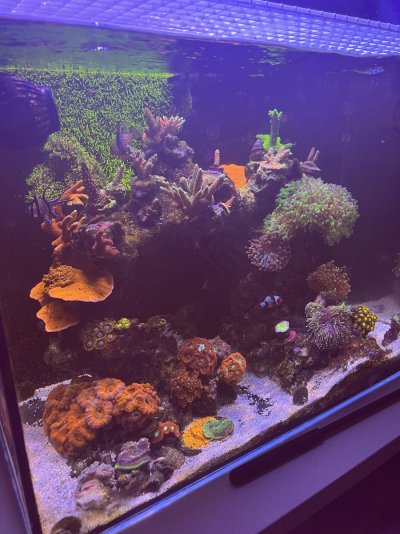
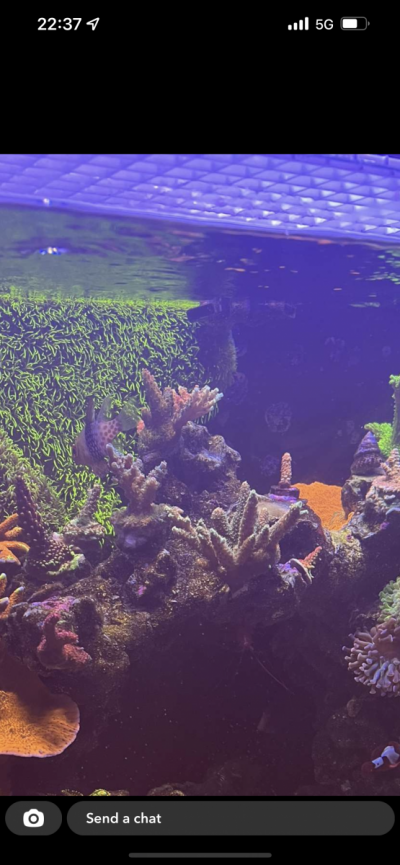
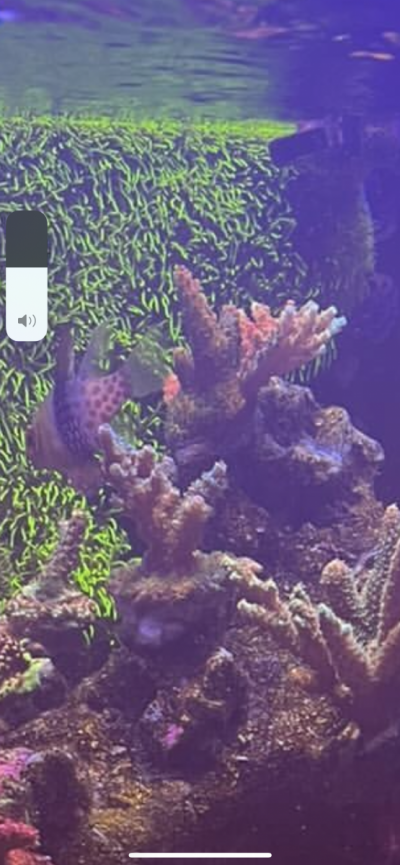
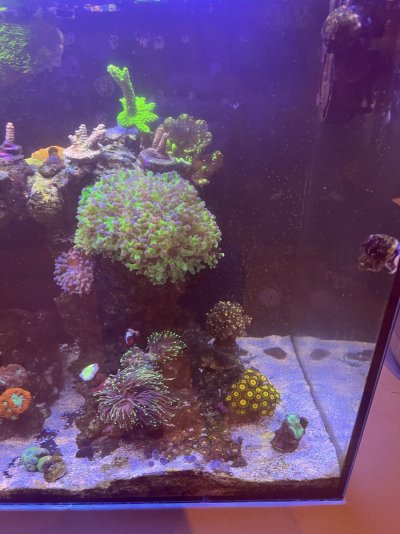
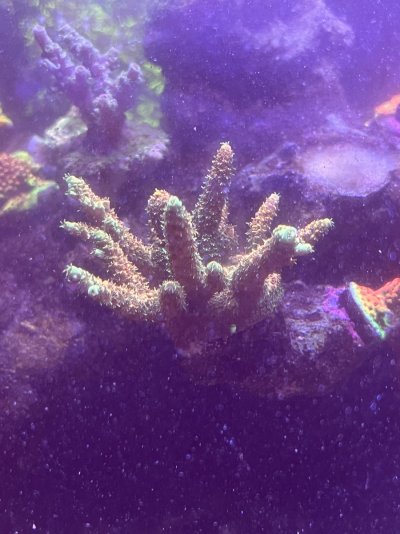
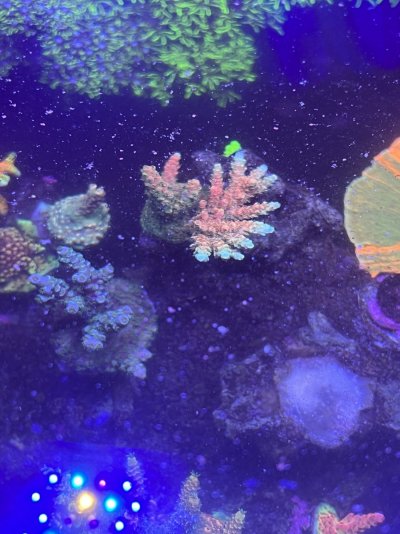
alk 8.0-8.5
Cal- 420-500
Mag- 1350-1450
Salinity: 1.026
nitrate-10-20 ppm
Phos- 0.06-.16
Tank is a water box aio 35.2
Have two radios g5 xr15 running the top shelf aquatics schedule modified with more whites
Have Red Sea doser: doing back up alk and nopox
Have Neptune doser doing kalk and aminos
Have learned that keeping things as stable as possible is the game.. alk swings def matter and salinity swings do too.
I run no socks and a protein skimmer.. that’s all
For phosphate management I use lanthium.
I have a trident monitoring the system every 3 hours and use a two part to correct but most not if not it’s all kalk that I dump over night as my ato equivilant.. I have an ato just in case but most of it is from the kalk.
Use aminos and trace elements and a bi monthly water change of about 30%






Last edited:
Keeping it simple, less variables to pinpoint when something does goes wrong. I have been keeping sps successfully for quite sometime, growing 1" frags to massive colonies in a few short years. I always tell folks is that keeping water is the secret and not concentrate in keeping corals specifically, pick a set of parameters and sticking with it long term and sps will adapt and become resilient. I don't really test much like I should, but have been doing this for quite sometime and you develop a sense that I can't really explain, so more often than not...I just test with my eyes. The corals tells me, if something is going sideways. I use to manually test alot, but all it did was drain my pockets and my reef tank never improved. Because all the chasing numbers never made my reef tank stable, is was all over the place and the corals was never able to adapt. I always used the same methods from day one, way back to 1996. As technology changes, so did the equipment I used. But the methods still are still the same.
My order of Importance...
1. Water (w/ IO or RC)
2. Flow
3. Lighting
4. Calc Reactor
5. Refugium w/miracle mud
And when I started to just sit back and let the reef tank do its thing, things started to take off and I stopped testing...only tested dkh maybe once a month. Also note, I don't use filter socks, and rarely use gfo or carbon. Maybe 2-3 times a year. Also Water changes once every month or 2. I'm not here to tell you not to test, if you have a system great, keep doing it. I'm here to tell you how I do it, and quite frankly it's as simple as you can get. My 2 cents....

My order of Importance...
1. Water (w/ IO or RC)
2. Flow
3. Lighting
4. Calc Reactor
5. Refugium w/miracle mud
And when I started to just sit back and let the reef tank do its thing, things started to take off and I stopped testing...only tested dkh maybe once a month. Also note, I don't use filter socks, and rarely use gfo or carbon. Maybe 2-3 times a year. Also Water changes once every month or 2. I'm not here to tell you not to test, if you have a system great, keep doing it. I'm here to tell you how I do it, and quite frankly it's as simple as you can get. My 2 cents....
Similar threads
- Replies
- 19
- Views
- 1,025

















